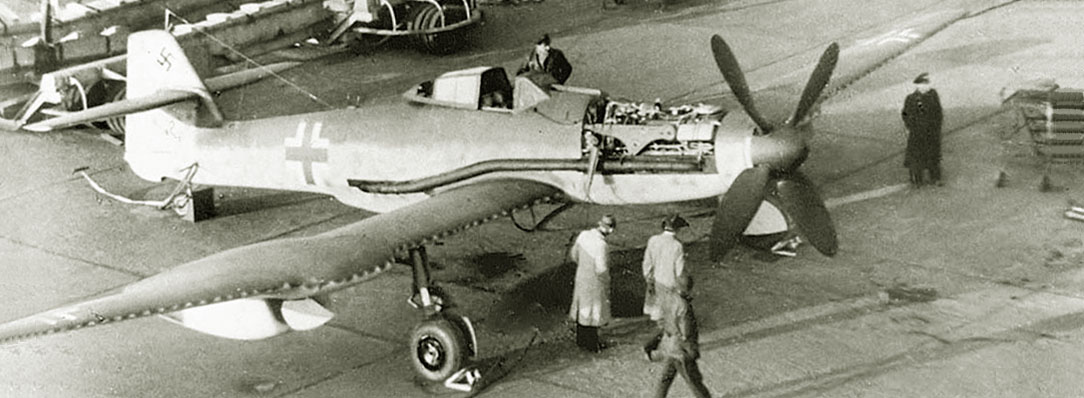|
BV.155
High Altitude Fighter-Interceptor
Blohm und Voss

 The design of the BV 155 high-altitude fighter-interceptor was almost completely developed in 1943 by engineers of the Messerschmitt company, however, by order of the German Aviation Ministry, Messerschmitt transferred the project to the Blom and Foss company, which was less loaded with military orders. The design of the BV 155 high-altitude fighter-interceptor was almost completely developed in 1943 by engineers of the Messerschmitt company, however, by order of the German Aviation Ministry, Messerschmitt transferred the project to the Blom and Foss company, which was less loaded with military orders.
It should be noted that the firm "Messerschmitt" was fatally unlucky with the number "155". Three times she designed aircraft with this number and three times she failed to bring the project to serial production.
The first Me 155 was a carrier-based fighter for the Graf Zeppelin aircraft carrier, which was under construction before the war. The aircraft was based on the Bf 109 and had folding wing consoles and a landing hook. In 1942, the construction of the aircraft carrier was discontinued, and the carrier-based fighter was no longer needed.
In the same 1942, the company designed the Me 155A high-speed bomber capable of carrying one bomb weighing 1000 kg. Then the project was rejected, and the company was asked to engage in a high-altitude fighter-interceptor to combat the Anglo-American bombers, systematically and practically with impunity destroying German cities by bombing from high altitudes.
In September 1943, the project of the Me 155B-1 high-altitude fighter-interceptor was basically ready, but the Ministry of Aviation ordered that it be handed over to the Hamburg firm "Blom and Voss" for fine-tuning and construction of prototypes, which at that time had free production areas.
The engineers of Blom & Foss, under the leadership of the chief designer of the Vogt company, made significant changes to the project. In particular, they designed a new high aspect ratio wing with a laminar profile, redesigned the landing gear, and also redesigned the aft fuselage. The design of the power plant of the first experimental modification of the BV 155B was left unchanged - as on the Me 155B-1.
The aircraft was equipped with a DB-603A engine, which operated in the following modes: when flying at low altitudes, only the engine supercharger is used, and at high altitudes also a two-stage turbocharger TKL 15, and the motor supercharger with a hydraulic clutch is used as a third stage. Under the wing, on both sides of the fuselage, there are large radiator installations. From the exhaust pipes, the exhaust gases are fed through long pipelines to a turbocharger located in the fuselage behind the cockpit. Air enters through the suction pipe at the bottom of the fuselage, passes through two stages of the turbocharger, and from there, through an intermediate radiator, it enters the supercharger pipe on the motor. After that, the air is cooled in an intermediate radiator and enters the motor.
Such a power plant at an altitude of 1550 m developed a power of 1450 liters. from. and ensured the achievement of a speed of 672 km/h at this altitude. The aircraft was equipped with a four-bladed propeller with a variable pitch in flight. The diameter of the propeller was 3.9 m. Placed in the box-shaped wing spar, the fuel supply was equal to 400 liters.
The semi-monocoque fuselage is made almost entirely of duralumin. In the fuselage compartment, located behind the cockpit, the TKL 15 turbocharger was installed.
The high aspect ratio wing had box-section spars and laminar profile. The wing housed fuel tanks, channels for the engine cooling system and radiators for the engine cooling system, as well as compartments for cleaning the main landing gear.
The second prototype BV 155C (project designation BVP.205) had a DB 603 U engine and the same TKL 15 turbocharger. The wing area of this aircraft was reduced to 35.6 m & # 178; (for BV 155B it was 39.0 m & # 178;). The fuel supply was 1200 liters. Losses of lift due to a decrease in wing area were partially compensated by lengthening the front fairing of the wing. Drawing of landing gear retraction has also changed - OOS are now retracted inside, to the plane of symmetry line. The chassis base was reduced from 6.7 to 3.9 m.
| 




